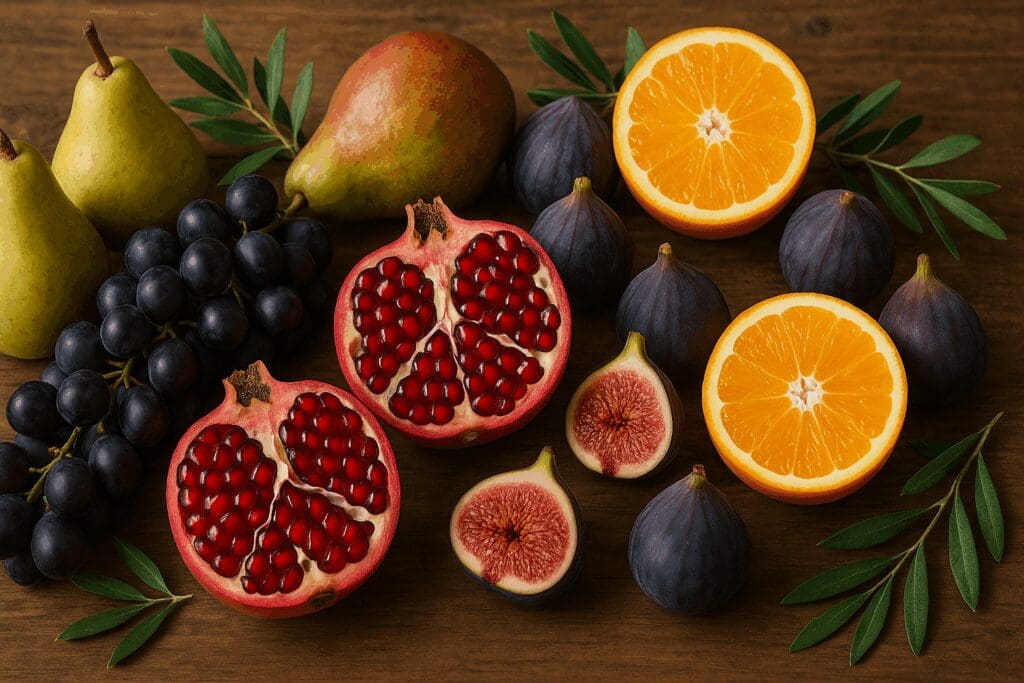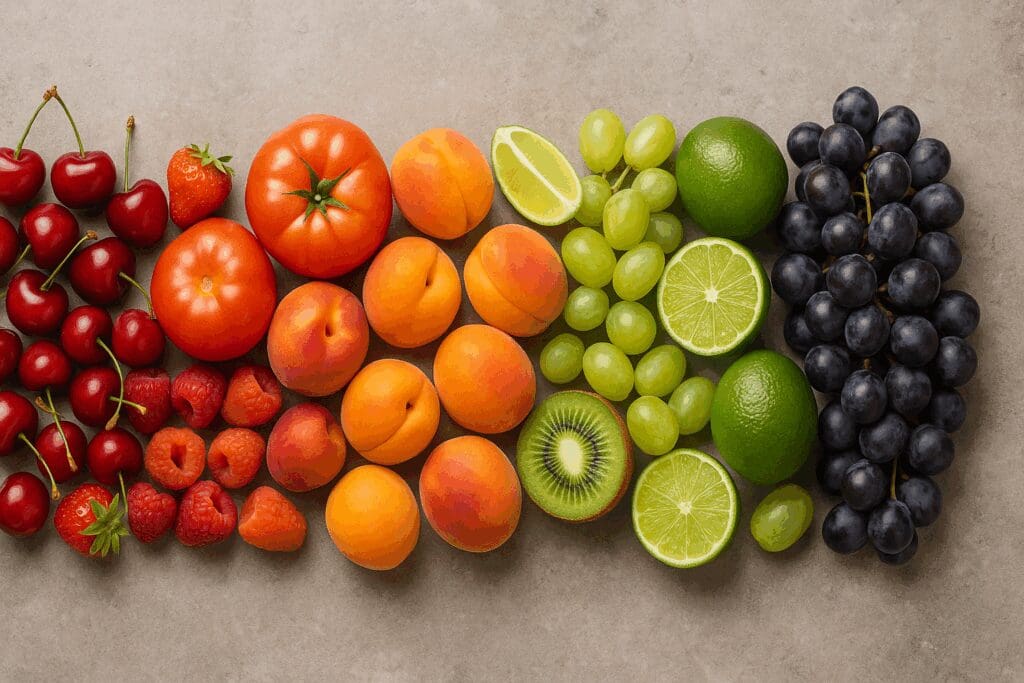Introduction: Embracing the Power of Mediterranean Fruits for Heart Health
In the landscape of nutritional science and preventive medicine, few dietary patterns have garnered as much praise and enduring relevance as the Mediterranean diet. At the heart of this plant-forward approach lies a diverse and colorful array of Mediterranean fruits, each offering a unique profile of antioxidants, fiber, vitamins, and phytonutrients. These fruits not only contribute to the sensory richness of Mediterranean cuisine but also play a pivotal role in supporting cardiovascular health. Their inclusion in daily meals exemplifies the synergy between flavor and function—where nourishment meets longevity.
For those wondering what is the Mediterranean diet consist of, it is important to understand that fruits are not mere garnishes but essential building blocks. They are present in nearly every meal, from fresh figs at breakfast to citrus-dressed salads at lunch and antioxidant-rich berries paired with olive oil-drizzled grains for dinner. This constant presence of fruit in meals aligns perfectly with the guiding principles of the Mediterranean diet food pyramid, which places fruits at its foundational level alongside vegetables, whole grains, and healthy fats. Consequently, Mediterranean fruits serve as both daily staples and disease-fighting agents in this time-tested dietary tradition.
In exploring the benefits of the Mediterranean diet, researchers consistently point to its cardioprotective properties. These include reduced blood pressure, improved cholesterol levels, and diminished systemic inflammation. Much of this impact can be attributed to the daily consumption of fruits rich in flavonoids, polyphenols, and soluble fiber—compounds that directly modulate vascular health. As we dive deeper into the world of Mediterranean fruits, we will uncover how these vibrant foods contribute to heart health, how they fit into a modern grocery list Mediterranean diet plan, and how they can be integrated into your daily meals with ease and delight.
You may also like: 10 Essential Tips on Choosing Healthy Food for Ladies to Boost Energy and Wellness

Understanding the Mediterranean Diet and Its Nutritional Philosophy
Before exploring the specific impact of Mediterranean fruits, it is important to understand the broader framework of the Mediterranean diet itself. Often regarded as one of the healthiest eating patterns globally, this diet is not a rigid meal plan but rather a flexible and culturally rich approach to food that varies across regions such as Greece, Italy, southern France, and parts of the Middle East. Despite regional differences, the central tenets remain the same: an emphasis on whole, minimally processed foods including fruits, vegetables, legumes, nuts, seeds, olive oil, fish, and whole grains, with moderate consumption of dairy and limited intake of red meat and sweets.
One of the defining characteristics of the Mediterranean diet is its emphasis on balance and pleasure rather than restriction. Unlike fad diets that categorize foods as inherently “good” or “bad,” the Mediterranean approach encourages diversity, portion mindfulness, and shared meals. This dietary philosophy promotes sustainable habits rather than short-term fixes. It’s not uncommon to hear someone ask is Mediterranean food healthy or what is Mediterranean food, and the answer lies in its ingredients, its moderate portion sizes, and its deep-rooted culinary traditions.
The med diet pyramid provides a visual guide for those interested in adopting this lifestyle. At the base are daily servings of fruits, vegetables, legumes, whole grains, and healthy fats—particularly extra virgin olive oil. Above these are fish and seafood (to be consumed several times a week), then poultry, eggs, and dairy in moderation. Red meats and sweets are situated at the very top, to be eaten sparingly. This model is not only nutritionally balanced but also adaptable, making it a viable framework for everything from Mediterranean diet meal prep to crafting a Mediterranean diet lunch that supports both satisfaction and satiety.
Moreover, the advantages of Mediterranean diet extend beyond cardiovascular benefits. This dietary pattern is associated with lower rates of type 2 diabetes, obesity, cognitive decline, and even certain cancers. These health outcomes are attributed not only to macronutrient balance but also to the abundance of micronutrients, bioactive compounds, and fiber found in plant-based staples—especially Mediterranean fruits. Their role in this diet is not to be underestimated, as they are instrumental in delivering both flavor and function in every bite.

The Heart-Healthy Benefits of Mediterranean Fruits
Mediterranean fruits contribute significantly to the diet’s cardiovascular benefits through a multifaceted nutritional profile that targets the underlying mechanisms of heart disease. One of the most important factors is their high concentration of antioxidants, particularly flavonoids and polyphenols, which help neutralize oxidative stress and reduce the damage to blood vessels. These compounds also enhance endothelial function—the ability of blood vessels to relax and contract efficiently—thus supporting healthy blood pressure and circulation.
Fruits such as pomegranates, grapes, figs, oranges, and olives are rich in polyphenolic compounds that exhibit anti-inflammatory, anti-hypertensive, and anti-atherogenic properties. For example, the anthocyanins in dark grapes and berries not only give them their rich color but also help lower LDL cholesterol and protect against plaque buildup in the arteries. Similarly, citrus fruits like oranges and mandarins are rich in vitamin C and hesperidin, a flavonoid that has been shown to improve blood vessel function and reduce markers of inflammation.
Fiber is another major contributor to the cardiovascular effects of Mediterranean fruits. Soluble fiber found in apples, pears, and figs helps lower cholesterol by binding bile acids in the digestive system, forcing the liver to use existing cholesterol to produce more bile. This mechanism, combined with the fruits’ low glycemic load, supports metabolic balance and reduces the risk of insulin resistance—a known risk factor for cardiovascular disease. For those exploring a Mediterranean diet to lose weight or seeking Mediterranean diet recipes for weight loss, incorporating fiber-rich fruits can aid in satiety, weight regulation, and blood sugar control.
Furthermore, Mediterranean fruits contribute to the regulation of blood pressure through their high potassium content. Potassium-rich fruits like apricots and bananas help counteract the effects of sodium, reducing tension in the blood vessels and promoting better fluid balance. This mineral synergy, combined with antioxidants and fiber, creates a cardiometabolic trifecta that reinforces the benefits of the Mediterranean diet for heart health. Including a variety of these fruits regularly can provide a potent, natural approach to maintaining a healthy cardiovascular system.

Mediterranean Fruits and the Anti-Inflammatory Advantage
Chronic inflammation is increasingly recognized as a driving force behind many degenerative diseases, including atherosclerosis, heart disease, and metabolic syndrome. Mediterranean fruits, with their rich array of anti-inflammatory compounds, serve as key tools in mitigating this insidious health threat. The wide variety of antioxidants, vitamins, and phytochemicals present in these fruits work together to modulate inflammatory pathways and protect cellular function. This makes them an indispensable part of any anti-inflammatory diet grounded in whole foods and seasonal produce.
Polyphenols, which are abundant in fruits like cherries, grapes, and pomegranates, play a crucial role in reducing inflammation. These compounds inhibit the activity of pro-inflammatory enzymes and cytokines, thereby blunting the body’s chronic inflammatory response. Studies have shown that regular consumption of polyphenol-rich fruits is associated with lower levels of C-reactive protein (CRP), a key marker of inflammation linked to cardiovascular events. This is particularly relevant for those seeking a high protein Mediterranean diet that still prioritizes anti-inflammatory balance through plant-derived foods.
In addition to polyphenols, vitamin C found in citrus fruits such as lemons, oranges, and grapefruits contributes to immune modulation and tissue repair. This antioxidant vitamin helps scavenge free radicals and regenerate other antioxidants, including vitamin E, which is critical for maintaining cellular integrity. The synergy between these nutrients enhances the body’s ability to respond to inflammation in a controlled and effective manner, supporting long-term heart health and reducing disease risk.
The fiber in Mediterranean fruits also contributes to reduced inflammation through its prebiotic effects. Soluble fiber nourishes beneficial gut bacteria, which in turn produce short-chain fatty acids (SCFAs) like butyrate—compounds known to reduce intestinal and systemic inflammation. This gut-heart axis further amplifies the cardioprotective and anti-inflammatory effects of Mediterranean fruits. When constructing a Mediterranean diet chart or a Mediterranean diet shopping list, including a wide range of anti-inflammatory fruits should be a top priority.
Equally important is the role that color diversity plays in the anti-inflammatory power of Mediterranean fruits. The deep reds of cherries, the bright oranges of apricots, the purples of grapes, and the greens of figs and kiwis each signify a different set of phytonutrients with unique protective effects. Consuming a rainbow of fruits not only provides visual and culinary satisfaction but also ensures broad-spectrum support for inflammatory regulation, reinforcing why mediterranean fruits deserve a central place in any heart-healthy diet.

Incorporating Mediterranean Fruits into a Modern Lifestyle
Integrating Mediterranean fruits into your daily routine does not require a complete overhaul of your current diet. Instead, it offers a refreshing and flexible approach that can be adapted to virtually any cultural or culinary background. Whether you are learning how to start the Mediterranean diet from scratch or simply looking to enhance your existing meal plan, adding more fresh, seasonal fruits is one of the easiest and most effective strategies. From breakfast to dinner—and even dessert—Mediterranean fruits offer countless opportunities to elevate both nutrition and taste.
A great starting point is to incorporate fruit into breakfast meals. A bowl of Greek yogurt topped with figs, berries, and a drizzle of honey not only honors traditional medi eats but also delivers a balance of protein, probiotics, and antioxidants. For a fiber-rich option, oatmeal with diced apples, pears, and a sprinkle of cinnamon evokes the comforting flavors of Mediterranean kitchens while promoting satiety and digestive health. These simple additions can transform your mornings and align your eating habits with the Mediterranean diet food list without complexity or added stress.
Snacks are another opportunity to reap the benefits of the Mediterranean diet through fruit consumption. Fresh dates, grapes, or citrus slices are easy to pack and provide a natural source of energy, vitamins, and hydration. For a more substantial option, pairing fruit with a handful of nuts or a piece of Mediterranean diet cheese like feta or ricotta can create a satisfying, balanced snack that supports blood sugar stability and reduces cravings. Including these pairings in your Mediterranean diet meal prep ensures that healthy options are always within reach.
When it comes to lunch and dinner, fruits can play both supporting and starring roles. A classic Mediterranean salad might feature tomatoes, cucumbers, olives, and red onion, but adding orange segments or pomegranate seeds introduces a burst of sweetness and complexity. In main dishes, figs can be roasted and served alongside poultry, or grapes can be reduced into a savory sauce for grilled fish. These combinations illustrate what to eat on the Mediterranean diet when seeking flavor innovation and nutritional variety.
For dessert, Mediterranean fruits shine in their natural form or with minimal enhancement. Baked apples with a dusting of cinnamon, grilled peaches with balsamic glaze, or fresh berries with a dollop of yogurt exemplify how satisfying and indulgent healthy eating can be. By embracing the versatility of Mediterranean fruits in every meal, individuals can enjoy the advantages of Mediterranean diet living in a way that feels joyful, practical, and sustainable.
The Science Behind Mediterranean Fruits and Longevity
In addition to their cardiovascular and anti-inflammatory benefits, Mediterranean fruits are increasingly studied for their role in promoting longevity. Researchers examining Blue Zones—regions with high concentrations of centenarians—often highlight the prominence of fruit in local diets. In many of these Mediterranean communities, fruit is not treated as an occasional indulgence but as an essential, daily staple that nourishes the body across the lifespan. This habitual consumption of fruit supports cellular health, hormone regulation, and resilience against chronic disease.
The polyphenols found in Mediterranean fruits have been shown to activate certain longevity-associated genes, such as sirtuins and AMP-activated protein kinase (AMPK). These genes are involved in cellular repair, mitochondrial function, and energy metabolism. Compounds in berries, grapes, and citrus fruits may promote autophagy—the body’s process of cleaning out damaged cells and regenerating new ones. This mechanism is critical for preventing age-related diseases, including neurodegenerative conditions like Alzheimer’s and Parkinson’s, which are also linked to inflammation and oxidative stress.
Another important factor is the glycemic profile of most Mediterranean fruits. Unlike ultra-processed snacks or sugary desserts, whole fruits contain fiber and water that slow down the absorption of natural sugars. This supports stable insulin levels and reduces the risk of metabolic syndrome—a cluster of conditions including high blood pressure, elevated glucose, and abdominal obesity. This metabolic balance is central to Mediterranean diet for weight loss strategies, as it encourages sustainable energy without triggering the insulin spikes and crashes associated with refined carbohydrates.
Moreover, the synergy of nutrients in whole fruits—rather than isolated components—provides more comprehensive protection. For example, the vitamin C in oranges works alongside flavonoids to enhance bioavailability and antioxidative potential, while the fiber in figs supports both digestion and microbiome diversity. This holistic nutritional impact makes Mediterranean fruits especially valuable for long-term health and vitality. Including a diverse selection of fruits in your Mediterranean diet meal plan is a scientifically grounded investment in both immediate wellness and lifelong resilience.
Perhaps most compelling is the psychological and emotional dimension of fruit consumption within the Mediterranean lifestyle. Sharing seasonal fruit at the table, engaging in mindful eating, and celebrating food’s natural beauty fosters a positive relationship with nutrition. These behaviors reinforce healthy habits and reduce stress, both of which contribute to longevity. In this way, the mediterranean diet pyramid is not only a tool for food selection but also a map for longevity-enhancing practices that center around connection, pleasure, and nourishment.
Mediterranean Fruits in the Context of the Food Pyramid
To fully appreciate the role of fruits in this renowned dietary framework, one must consider their placement in the Mediterranean diet pyramid. Fruits sit at the base, indicating that they should be consumed daily in generous portions alongside vegetables, legumes, and whole grains. This foundational status reflects their nutrient density and their role in supporting nearly every aspect of health. Unlike restrictive diets that limit fruit intake due to carbohydrate content, the Mediterranean model celebrates fruit as a crucial element of holistic well-being.
This placement also offers clarity for those new to the diet who may ask what does the Mediterranean diet consist of or what foods are not allowed on Mediterranean diet. The pyramid does not ban foods outright but rather encourages prioritization. Fruits are in the “eat most often” category, while red meats, sweets, and heavily processed items are to be enjoyed sparingly. This visual guide supports flexible implementation across various contexts, allowing individuals to tailor their Mediterranean diet chart to personal preferences and seasonal availability.
Importantly, the pyramid’s structure supports a cumulative and sustainable approach to health. Rather than focusing on a single superfood or supplement, it promotes the idea of synergy among foods. Mediterranean fruits, when consumed in combination with olive oil, whole grains, nuts, and lean proteins, enhance nutrient absorption and metabolic efficiency. For example, eating fruit with a source of healthy fat—such as a salad dressed in olive oil or yogurt with seeds—can improve the absorption of fat-soluble vitamins like A, E, and K.
Understanding this pyramid is also crucial for effective meal planning and grocery shopping. A well-rounded Mediterranean diet shopping list might include apples, grapes, oranges, figs, dates, pomegranates, and seasonal stone fruits such as apricots or peaches. Including these items regularly ensures that the diet remains colorful, nutrient-rich, and aligned with tradition. By viewing the pyramid as both a nutritional and cultural guide, individuals can engage with Mediterranean eating as a lifestyle rather than a temporary diet.
Ultimately, the pyramid serves not just as a diagram but as a philosophy that reflects balance, abundance, and variety. Fruits, as one of the cornerstones of this structure, offer an accessible and enjoyable means of anchoring the diet in both scientific credibility and cultural authenticity. Their elevated status within the Mediterranean food pyramid reaffirms their central role in achieving a heart-healthy, anti-inflammatory, and longevity-supporting diet.

Exploring Regional Variety: Mediterranean Fruits Across Different Cultures
One of the most fascinating aspects of Mediterranean fruits is the rich regional variety that defines different parts of the Mediterranean basin. From Spain to Lebanon, from southern France to coastal Turkey, each culture cultivates and celebrates unique fruits that reflect its geography, climate, and culinary traditions. Understanding this diversity not only adds dimension to the Mediterranean diet meal plan but also opens the door to a more vibrant and culturally immersive eating experience. These regional fruits are not simply additions to the plate—they are vital expressions of history, agriculture, and seasonal rhythm.
In Greece, figs and grapes reign supreme, often consumed fresh or dried and paired with yogurt, cheese, or bread. These fruits are deeply embedded in Greek mythology and history, symbolizing abundance and divine nourishment. Figs, in particular, are known for their high fiber and mineral content, making them a staple in the Greek version of the Mediterranean diet food list. Moving westward to Italy, citrus fruits such as blood oranges and lemons take center stage, especially in Sicily and the Amalfi Coast. These fruits are often incorporated into salads, seafood dishes, and desserts, showcasing their versatility and bright, refreshing profile.
Spain brings a different bounty to the table, with an emphasis on stone fruits like apricots, peaches, and plums, particularly in regions like Andalusia. The arid climate and long growing season allow for intense sweetness and rich flavor concentration. These fruits are not only consumed fresh but also used in traditional compotes, jams, and savory sauces that enhance meats or legumes. In Middle Eastern Mediterranean countries such as Lebanon and Israel, pomegranates and dates play a central role. These fruits are revered both nutritionally and symbolically, often featured in religious traditions and festive meals. Their antioxidant density and energizing natural sugars make them ideal for heart health and sustained energy.
North African countries, including Morocco and Tunisia, contribute their own unique offerings, such as prickly pear, melons, and various citrus hybrids. These fruits are often enjoyed as part of light meals or incorporated into tagines and couscous-based dishes, reinforcing the concept that what to eat on Mediterranean diet includes diverse culinary interpretations that transcend rigid guidelines. This regional variety ensures that the diet remains exciting, adaptable, and rooted in seasonality.
For anyone seeking to deepen their connection to the benefits of the Mediterranean diet, exploring these regional fruits can be both a culinary adventure and a health-enhancing strategy. Whether you’re crafting a culturally themed dinner or simply trying a new variety at your local market, embracing the full spectrum of Mediterranean fruits adds authenticity and nutritional depth to your dietary journey.
Mediterranean Fruits and Their Role in a High-Protein Mediterranean Diet
While fruits may not be protein powerhouses in themselves, they play an essential supportive role in the success of a high protein Mediterranean diet. Their unique nutrient profiles complement protein-rich foods by enhancing digestion, improving nutrient absorption, and balancing blood sugar. When strategically paired with lean proteins such as fish, legumes, poultry, or yogurt, Mediterranean fruits round out the meal with fiber, antioxidants, and hydration, contributing to metabolic balance and satiety.
One practical way to incorporate this synergy is through well-composed meals that unite fruit and protein on the same plate. For instance, a grilled chicken salad with orange segments and a tahini dressing provides a mix of complete protein, vitamin C, and healthy fats. The citrus not only brightens the dish but also improves iron absorption from plant-based proteins like lentils or chickpeas. Similarly, cottage cheese with sliced figs or a parfait of Greek yogurt, berries, and nuts delivers a blend of protein and phytonutrients ideal for muscle repair and heart health.
This pairing strategy is particularly beneficial for individuals pursuing Mediterranean diet for weight loss, as it supports lean muscle mass while curbing cravings. Fruits help regulate appetite through their fiber and water content, preventing the overeating that can occur with more calorie-dense foods. Additionally, their natural sweetness provides a healthful alternative to processed desserts, allowing for indulgence without compromising dietary goals. In a broader nutritional context, Mediterranean fruits also help buffer the acid-forming effects of high-protein foods, promoting pH balance and kidney health.
For athletes or active individuals, the inclusion of fruit in a high protein Mediterranean diet aids in recovery by replenishing glycogen stores and reducing exercise-induced inflammation. Post-workout meals featuring protein-rich foods alongside fruits like cherries or bananas not only restore energy but also protect against oxidative stress. This functional integration of fruit and protein exemplifies the Mediterranean approach—where meals are crafted not just for taste, but for total-body wellness.
Ultimately, the collaboration between Mediterranean fruits and protein-rich staples strengthens the overall impact of the diet. Whether you’re aiming to lose weight, enhance performance, or simply eat more mindfully, understanding how fruit can enhance your high-protein meals brings both culinary satisfaction and nutritional integrity to the table.

Building Your Mediterranean Diet Grocery List with Fruits in Focus
One of the most practical ways to ensure consistent fruit intake is by curating a grocery list Mediterranean diet style, with fruits at the forefront. This process begins with an awareness of seasonal availability, which enhances both taste and nutritional value. Buying fruits in season not only supports local agriculture but also ensures that your meals remain dynamic, flavorful, and aligned with the rhythm of nature. From a budgetary standpoint, seasonal fruits are often more affordable and environmentally sustainable.
When creating your list, consider including a mix of fresh, dried, and preserved fruits. Fresh options such as grapes, oranges, pomegranates, and pears are ideal for daily consumption. Dried fruits like apricots, dates, and figs can serve as portable snacks or natural sweeteners in baked goods and salads. Preserved fruits, including compotes or jams made with minimal added sugar, can complement cheeses or whole grain breads in moderation. By diversifying your fruit choices, you prevent palate fatigue and ensure a full spectrum of phytonutrient intake.
It’s also wise to align your grocery list with your Mediterranean diet meal prep strategy. For example, if you plan to make smoothies, parfaits, or fruit-based sauces, you may want to stock up on frozen fruits like berries or mango. These retain most of their nutrients and offer convenience without compromising quality. When planning lunches, fruits such as apples, tangerines, and plums can be easily packed and paired with a protein or fat source for balanced energy throughout the day.
For those just beginning to explore how to start the Mediterranean diet, creating a fruit-centric shopping list is a user-friendly entry point. It provides tangible structure while leaving ample room for creativity. In addition to selecting fruits, consider pairing them with complementary items such as nuts, yogurt, leafy greens, or whole grains. This promotes the holistic nutrient pairing that defines the Mediterranean approach and enhances both satiety and absorption.
By making Mediterranean fruits a core focus of your weekly grocery planning, you lay a strong foundation for consistent, nourishing meals. The act of shopping with intentionality also fosters mindfulness, encouraging you to savor the sourcing, preparation, and enjoyment of food as part of a heart-healthy lifestyle. As simple as it sounds, your grocery list can be a powerful tool in unlocking the full benefits of the Mediterranean diet and sustaining them long-term.
Frequently Asked Questions: Mediterranean Fruits, Food Philosophy, and Practical Living on the Mediterranean Diet
1. How do Mediterranean fruits contribute to long-term brain health and mental clarity?
Mediterranean fruits such as figs, pomegranates, oranges, and grapes are exceptionally high in antioxidants like polyphenols and flavonoids, which play a protective role in preserving cognitive function. While the article may highlight general health benefits, recent research dives deeper into their neuroprotective mechanisms—showing how compounds in grapes and citrus fruits enhance synaptic plasticity and delay age-related memory decline. These fruits also have anti-inflammatory effects that reduce neuroinflammation, a contributor to conditions like Alzheimer’s and Parkinson’s disease. Moreover, Mediterranean fruits are rich in water and natural sugars that support optimal neurotransmitter function without the blood sugar spikes common in processed snacks. Adding these fruits regularly into a Mediterranean diet meal plan can be a subtle yet powerful step toward maintaining mental sharpness as you age.
2. What are the overlooked cultural and emotional benefits of the Mediterranean diet?
Beyond physical health, the Mediterranean diet promotes emotional well-being by emphasizing shared meals, slow eating, and local, seasonal foods that foster connection and mindfulness. These cultural rituals—often overlooked in clinical discussions—are essential to the longevity seen in Mediterranean populations. The diet encourages social eating, often over leisurely lunches with family, which has been linked to lower rates of depression and anxiety. Preparing Mediterranean diet lunch dishes from scratch fosters a sense of routine and purpose, both vital components of emotional stability. When considering the full advantages of Mediterranean diet living, these intangible yet deeply human factors cannot be ignored.
3. Can a high protein Mediterranean diet support muscle growth and fitness goals?
Absolutely. While traditionally lower in red meat, the Mediterranean diet is highly adaptable for fitness-focused individuals seeking higher protein intake. Lean protein sources like grilled fish, skinless poultry, Greek yogurt, and legumes can be seamlessly integrated without straying from the core principles. Adding high-protein vegetables like spinach, artichokes, and broccoli—alongside hard cheeses approved in the Mediterranean diet cheese category—can elevate protein content. For active adults or athletes, protein-rich Mediterranean diet meal prep options using lentils, tuna, or eggs with olive oil can support muscle synthesis and repair. A high protein Mediterranean diet can be both sustainable and performance-enhancing, especially when paired with consistent exercise.
4. What fruits are essential in a seasonal grocery list Mediterranean diet adherents should follow?
Creating a seasonal grocery list Mediterranean diet followers can rely on requires awareness of both nutrition and tradition. In spring, look for apricots, cherries, and strawberries. Summer brings figs, melons, and stone fruits like nectarines. Fall offers grapes and apples, while winter emphasizes citrus like blood oranges and mandarins. These Mediterranean fruits not only offer varied nutrients across the year but also align with the local, sustainable ethos of the diet. Shopping seasonally also enhances flavor, reduces costs, and supports small-scale farmers, making it a smart strategy for those committed to Mediterranean eating values.
5. How can the Mediterranean diet to lose weight be customized for modern busy lifestyles?
To adopt the Mediterranean diet to lose weight effectively while juggling work, parenting, or travel, simplicity and batch preparation are key. Focus on nutrient-dense, low-calorie staples like zucchini noodles, canned sardines, and quick-roasted chickpeas. Prepare bulk servings of lentil soup, tabbouleh, or grilled vegetables ahead of time as part of your Mediterranean diet meal prep strategy. Portable Mediterranean diet lunch ideas—such as olive-studded quinoa bowls or Greek yogurt with fresh Mediterranean fruits—can help maintain momentum throughout the week. Leveraging convenience without sacrificing the principles of whole, minimally processed food makes weight loss on this diet both feasible and sustainable.
6. What are some common misconceptions about what foods are not allowed on Mediterranean diet plans?
Many believe what foods are not allowed on Mediterranean diet lists include all forms of dairy, grains, or even red wine—this isn’t accurate. The diet doesn’t ban food as much as it discourages excess and promotes moderation. Processed snacks, sugary beverages, refined flours, and hydrogenated oils are minimized—not strictly outlawed. Full-fat dairy like traditional Mediterranean diet cheese and whole grains such as farro or bulgur are actually encouraged in moderate amounts. Understanding what the Mediterranean diet consist of requires nuance; it’s about balance, not rigid restriction.
7. How do the benefits of the Mediterranean diet extend to hormonal and reproductive health?
Emerging studies indicate the benefits of the Mediterranean diet also include hormonal balance, particularly in women dealing with PCOS, perimenopause, or thyroid issues. Healthy fats from olive oil and nuts support estrogen synthesis, while complex carbs from whole grains stabilize insulin. The polyphenols in Mediterranean fruits like pomegranates and berries have shown to reduce oxidative stress on the endocrine system. Furthermore, the diet’s high fiber intake supports detoxification pathways in the liver, aiding hormonal clearance. For individuals seeking holistic hormonal support, the Mediterranean framework is a valuable and often overlooked ally.
8. What role does the med diet pyramid play in nutritional literacy and behavior change?
The med diet pyramid is more than a food guide—it’s a behavior-change blueprint. Its foundation includes lifestyle elements like physical activity and communal meals, emphasizing how Mediterranean diet food list choices are inseparable from cultural context. Unlike static food charts, the Mediterranean diet pyramid is dynamic, promoting plant-based staples at the base and suggesting less frequent intake of meats and sweets at the top. This model simplifies decision-making, particularly for those new to the diet and unsure how to start the Mediterranean diet. Its intuitive structure encourages not only healthier eating but also mindful living.
9. Is it possible to follow the Mediterranean diet for weight loss while being vegetarian or vegan?
Yes, the Mediterranean diet for weight loss is highly plant-friendly and can be adapted to vegetarian or vegan lifestyles without losing its nutritional integrity. Staples like lentils, beans, olives, nuts, and whole grains provide complete protein and healthy fats. Mediterranean diet food pyramid guidelines can easily be followed using plant-based options like dairy-free cheeses, tofu cooked in olive oil, and eggplant or mushrooms as meat substitutes. Seasonal Mediterranean fruits and vegetables ensure satiety while keeping caloric intake in check. The flexible nature of what to eat on Mediterranean diet plans makes it inclusive for nearly every dietary preference.
10. Exploring Lesser-Known Mediterranean Fruits in Everyday Recipes and Snacks
While common Mediterranean fruits like grapes and figs are well-known, others—such as loquats, mulberries, and prickly pears—offer a nutrient-dense twist to daily meals. These lesser-known fruits can elevate everything from Mediterranean diet lunch salads to homemade yogurt parfaits. Their high fiber and antioxidant content align perfectly with Mediterranean diet recipes for weight loss, helping to curb appetite and improve gut health. Incorporating these fruits adds cultural diversity and deepens appreciation for regional traditions behind Mediterranean diet food list choices. As part of a rotating Mediterranean diet shopping list, these fruits can reinvigorate your meals and expand your palate.
Conclusion: The Lifelong Rewards of Prioritizing Mediterranean Fruits
Mediterranean fruits are far more than sweet additions to a healthy diet—they are foundational to the heart of Mediterranean living. Rich in antioxidants, fiber, and life-enhancing nutrients, these vibrant foods are central to the diet’s ability to reduce cardiovascular risk, combat inflammation, and promote metabolic balance. Whether enjoyed fresh from the vine, tossed into a colorful salad, or folded into a wholesome dessert, fruits offer a sensory and nutritional experience that few other food groups can match.
As part of a balanced Mediterranean diet chart or meal plan, fruits harmonize with legumes, whole grains, seafood, and olive oil to create meals that nourish both the body and the spirit. Their presence in the Mediterranean diet food pyramid affirms their importance not only in terms of frequency but in nutritional impact. When embraced fully, Mediterranean fruits support goals ranging from weight management to disease prevention to longevity—demonstrating that food truly is medicine when approached with wisdom and joy.
Moreover, integrating these fruits into your lifestyle through a well-planned Mediterranean diet shopping list or personalized meal prep routine fosters sustainability. These daily habits compound over time, resulting in improved well-being, stronger immunity, and a deeper connection to food. From the first bite of a sun-ripened fig to the vibrant splash of citrus in a winter salad, every encounter with Mediterranean fruits is an opportunity to enrich your life with color, flavor, and vitality.
Whether you are new to the Mediterranean lifestyle or have long admired its time-tested health benefits, let this guide inspire you to prioritize fruits as essential allies in your journey toward a heart-healthy, joy-filled life. The science is clear, the tradition is rich, and the flavors are unparalleled. In the end, the Mediterranean way isn’t just a diet—it’s a celebration of what it means to live well, and Mediterranean fruits are its sweetest ambassadors.
Further Reading:
Mediterranean diet: Foods to eat, health benefits and how to get started



